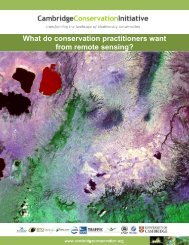CONSERVING BIODIVERSITY & DELIVERING ECOSYSTEM SERVICES
conserving biodiversity & delivering ecosystem services
conserving biodiversity & delivering ecosystem services
Create successful ePaper yourself
Turn your PDF publications into a flip-book with our unique Google optimized e-Paper software.
Birds are an important component of biodiversity. They are involved in many ecosystem functions through their role as<br />
scavengers (see box), pollinators and seed dispersers, and in pest control. In Nepal birds such as the Asian Openbill, Lesser<br />
Adjutant and Sarus Crane feed in agricultural fields and control many harmful insects and other invertebrates that would<br />
otherwise damage crops and reduce yields. Birds are also important as an ecosystem service ‘good’ in their own right in terms<br />
of the pleasure they give to millions of birdwatchers and nature lovers around the world, and are often the basis for lucrative<br />
eco-tourism ventures. Many people enjoy just having birds around them and their homes, such as Oriental Magpie Robin which<br />
occurs in the mid-hills and lowland villages and towns in Nepal.<br />
As well as being of value in themselves, birds can also be considered as important indicators of the more general state of<br />
ecosystem health. Knowledge of the state of a country’s birds can therefore give an indication of how well the country’s<br />
ecosystems are delivering benefits to people.<br />
Vultures: a special case<br />
Vultures fulfil an extremely important ecological role. As scavengers, they keep the environment free of carcasses and waste,<br />
restrict the spread of diseases such as anthrax and botulism, and help control numbers of pests, such as rats and dogs, by<br />
reducing the food available to them. They are of cultural value to some communities and have important eco-tourism value<br />
too. Vultures in South Asia have declined drastically (some species by up to 99%) in recent years predominantly as a result of<br />
widespread use of the non-steroidal anti-inflammatory drug diclofenac in livestock. Vultures become exposed to the drug by<br />
feeding on large animal carcasses, particularly cattle, treated with the drug. Their decline not only risks extinction of the<br />
global population of several vulture species, but also has negative impacts for human well-being.<br />
Fewer vultures result in:<br />
White-rumped Vulture<br />
(Jyotendra Jyu Thakuri)<br />
Economic impacts<br />
■ Burial/incineration results in loss of supply of dead cattle for<br />
tanning industry<br />
■ Profitability for traditional professions (e.g. bone collecting) reduced<br />
■ Carcass disposal costs<br />
■ Fewer tourists attracted by viewing vultures<br />
Health impacts<br />
■ Uneaten carcasses can be sources of a range of infectious diseases<br />
■ An increase in other scavenger populations (e.g. feral dogs) may<br />
increase risk from disease exposure including rabies<br />
Social impacts<br />
■ Cultural and religious values lost<br />
■ Utility values to Parsee communities in India lost<br />
■ Existence value diminished<br />
Environmental impacts<br />
■ Pollution from rotting carcasses (air, soil, water)<br />
<br />
Nepal is renowned internationally for its rich diversity of bird<br />
species. A total of 871 species has been recorded in the<br />
country, over 8% of the world’s known birds in just 0.1% of its<br />
land mass. In 2010, a review of the status of Nepal’s birds<br />
showed that 149 species—nearly one in five—were<br />
considered threatened at the national level, an increase of<br />
over 10% compared with a similar assessment undertaken in<br />
2004. Around 100 of these species were thought to be on the<br />
very edge of extinction (see figure and p.34 for information<br />
on determining the status of Nepal’s birds).<br />
The national Red List status for Nepal’s birds in 2004 and 2010<br />
Vulnerable<br />
Endangered<br />
Critically<br />
Endangered<br />
SOURCE BCN and DNPWC (2011) The state of Nepal’s birds 2010. Kathmandu: Bird<br />
Conservation Nepal and Department of National Parks and Wildlife Conservation.




